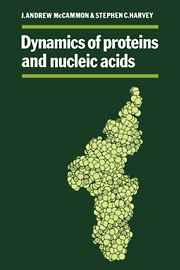Book contents
- Frontmatter
- Contents
- Preface
- 1 Introduction
- 2 Structure of proteins, nucleic acids, and their solvent surroundings
- 3 Dynamics of proteins, nucleic acids, and their solvent surroundings
- 4 Theoretical methods
- 5 Short time dynamics
- 6 Local structural transitions
- 7 Global structural changes
- 8 Dynamics of molecular associations
- 9 Recent developments and future directions
- Appendix 1 Numerical integration of the equations of motion
- Appendix 2 Detailed description of computer programs and procedures for energy minimization and molecular dynamics
- Appendix 3 Molecular dynamics at constant temperature and pressure
- References
- Index
6 - Local structural transitions
Published online by Cambridge University Press: 05 June 2012
- Frontmatter
- Contents
- Preface
- 1 Introduction
- 2 Structure of proteins, nucleic acids, and their solvent surroundings
- 3 Dynamics of proteins, nucleic acids, and their solvent surroundings
- 4 Theoretical methods
- 5 Short time dynamics
- 6 Local structural transitions
- 7 Global structural changes
- 8 Dynamics of molecular associations
- 9 Recent developments and future directions
- Appendix 1 Numerical integration of the equations of motion
- Appendix 2 Detailed description of computer programs and procedures for energy minimization and molecular dynamics
- Appendix 3 Molecular dynamics at constant temperature and pressure
- References
- Index
Summary
Introduction
Local structural transitions are of great importance in biological activity. The binding and release of ligands by proteins or nucleic acids often involves displacements of certain groups within the macromolecule as well as the displacement of the ligand itself. The rates of some enzyme–substrate reactions are determined by the time required for rearrangement of covalent bonds in elementary reaction steps, or by the time required for reorientation of a catalytically important sidechain between such steps. Also, important changes in the large scale structure of biopolymers may sometimes proceed via a sequence of more localized transitions.
Local transitions generally occur on relatively long time scales because they are activated processes. That is, they involve the crossing of free energy barriers that separate the initial and final configurations. Such transitions are occasionally observed during conventional molecular dynamics simulations. For example, three backbone amide groups underwent 180° rotations in the first protein simulation (McCammon et al, 1977). Examination of these revealed that structural relaxation and collisional damping due to the motion of neighboring protein atoms determine the character of the local transitions. Because such transitions occur infrequently, they cannot be studied systematically by the conventional simulation approach, however. The adiabatic mapping method described in section 4.5 provides a systematic but approximate method for studying local transitions. The activated dynamics method described in section 4.9 provides a detailed approach, but is more demanding of computational resources.
- Type
- Chapter
- Information
- Dynamics of Proteins and Nucleic Acids , pp. 117 - 136Publisher: Cambridge University PressPrint publication year: 1987

